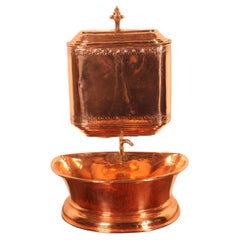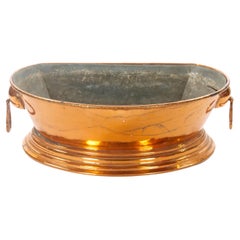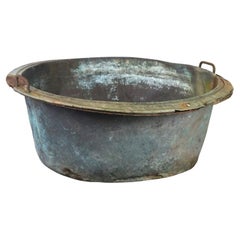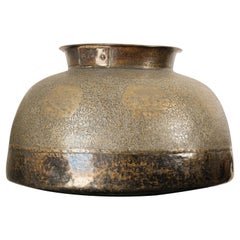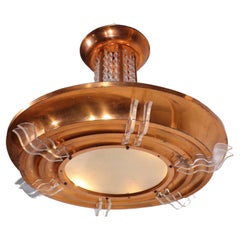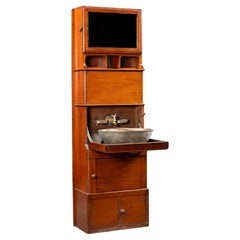Copper Basin
to
5
44
19
53
7
3
7
4
1
1
1
1
1
1
1
1
11
21
21
10
7
8
1
1
1
2
47
43
12
8
7
33
17
13
12
9
63
57
63
1
1
1
Sort By
Fountain and Its Copper Basin, 18th Century
Located in Brussels, Brussels
Superb fountain and its 18th century copper basin.
The fountain is in perfect condition and has
Category
Antique 18th Century French Louis XV Decorative Art
Materials
Copper
Large copper basin, silver inlaid, Egypt, 19th c. or before.
Located in PARIS, FR
Large silver damask copper basin decorated with scrolls, arabesques and foliage, encircling thuluth
Category
Antique 1880s Egyptian Islamic Decorative Dishes and Vide-Poche
Materials
Silver, Copper
Large English Antique Copper Basin / Lions Head Side Handles
Located in Tarry Town, NY
This substantial English copper basin from the mid-19th century exudes classic elegance and superb
Category
Antique Mid-19th Century English Planters, Cachepots and Jardinières
Materials
Metal, Brass, Copper
Copper Basin with Antique Scroll Base
Located in Bloomfield Hills, MI
A delightfully rusty antique base supports a lusciously weathered copper bowl. Ready for your
Category
20th Century Fireplaces and Mantels
Materials
Copper
Antique Middle Eastern Islamic Turkish Ewer and Copper Basin
Located in North Hollywood, CA
Handcrafted antique 19th century copper Middle Eastern Islamic copper ewer with basin.
The Turkish
Category
Antique 19th Century Turkish Moorish Metalwork
Materials
Copper
Unique large antique copper kettle/basin with a stunning patina
Located in Harderwijk, NL
. Antique copper basins already captivate the imagination of many, let alone one of this size, blessed with
Category
Antique 19th Century Decorative Bowls
Materials
Copper
$444 Sale Price
25% Off
H 14.97 in Dm 35.83 in
Large Fine Antique Islamic Inlaid Indo-Persian Copper Mughal Vessel
Located in North Hollywood, CA
brass bowl.
Large Mamluk copper basin finely etched and inlaid with Arabic Calligraphy and floral
Category
Antique 19th Century Indian Islamic Metalwork
Materials
Brass, Copper
Large Art Deco Copper and Lucite Chandelier, circa 1930s
By Atelier Jean Perzel
Located in New York, NY
Voguish Art Deco chandelier, in copper, lucite and glass. The fixtures a circular bottom basin ( 32
Category
Mid-20th Century American Art Deco Chandeliers and Pendants
Materials
Copper
Early 20th Century Mahogany Ship Dresser and Wash Basin
Located in Dekalb, IL
below. Below this is a small, copper basin sink with plumbing and and a faucet with a central knob and
Category
Early 20th Century American Dressers
Materials
Brass, Copper
Vintage Bassett Maple Dry Sink Cabinet with Copper Lined Basin
By Bassett Furniture
Located in Germantown, MD
Vintage Bassett maple dry sink cabinet with copper lined basin. Very good vintage condition. Brass
Category
Mid-20th Century American American Classical Cabinets
Materials
Brass, Copper
Ramina Ceramic Vase by Arianna De Luca
Located in Geneve, CH
Italian villages. The vase revisits shapes and proportions of the "conca", a traditional copper basin from
Category
2010s Italian Modern Vases
Materials
Ceramic
Art Deco Illuminated Urn Basin
Located in NANTES, FR
Large Art Deco illuminated urn basin, circa 1930.
Made of bronze and copper, decorated with a
Category
Mid-20th Century French Art Deco Table Lamps
Materials
Bronze, Copper
18th Century Turkish Tombak Ewer and Basin
Located in London, GB
This beautiful ewer and basin set is a delightful product of the 18th century Ottoman Empire, with
Category
Antique 18th Century Turkish Pitchers
Materials
Copper
Large English Silver Plated Centerpiece Basin / Jug
Located in Tarry Town, NY
Mid 20th century English silver plated Edwardian style large centerpiece / wash basin and jug. The
Category
Vintage 1930s English Edwardian Sheffield and Silverplate
Materials
Silver Plate, Copper
The Temperance/ Rosewater Basin by Elkington
Located in London, GB
copper silver plated Temperance Basin was made by Elkington & Co is a copy of the original Temperance
Category
Antique 19th Century Sheffield and Silverplate
Materials
Silver Plate
Antique 18th Century Heavy Hand Hammered British Brass Basin, BS#02
Located in Norton, MA
This is a large and old brass basin, thick and heavy gauge absolutely 100% hand-hammered brass made
Category
Antique 18th Century English Fireplace Tools and Chimney Pots
Materials
Brass, Copper
Antique 18th Century Large Hand Hammered British Brass Basin, BS#01
Located in Norton, MA
This is a large and old brass basin, absolutely 100% hand-hammered brass made from the 18th century
Category
Antique 18th Century English Victorian Fireplace Tools and Chimney Pots
Materials
Brass, Copper
Bronze Large Ewer and Basin by Robert Gugny and Leopold Oudry & Cie. Signed
Located in Kingston, NY
Ewer and its frame in bronze and metal with copper, silver and gold patinas. It is decorated with
Category
Antique Late 19th Century French Renaissance Pitchers
Materials
Metal, Bronze, Copper
$2,200
H 17.7 in W 17.7 in D 15.75 in
Modern Hand Forged, Formed, and Polished Copper Serving Spoons
Located in Brooklyn, NY
piece is hand fabricated from copper sheets. The basins are domed and then soldered to the forged
Category
2010s American Modern Barware
Materials
Copper
$675 / item
H 11.024 in W 2.953 in D 0.25 in
Modernist 20th Century Wall Fountain
Located in Denton, TX
Trapezoid shaped granite wall mounted with copper lighted shroud on top and copper catch basin at
Category
20th Century North American Modern Fountains
Materials
Granite, Metal, Copper
Antique Bible Print Interior of the Temple of Solomon by J. Luyken, 1743
Located in Langweer, NL
great copper wash basin."
This print originates from ‘Biblia Sacra, dat is, de H. Schriftuer van het
Category
Antique Mid-18th Century Prints
Materials
Paper
$335 Sale Price
20% Off
H 15.44 in W 18 in D 0.02 in
Contemporary Hand Thrown Fired and Glazed Japanese Inspired Fountain
Located in East Hampton, NY
Contemporary American hand thrown fired and glazed fountain with copper basin.
Category
21st Century and Contemporary American Fountains
Materials
Terracotta
French Portable Washstand
By Flicoteaux Boutet Et Cie
Located in London, GB
Portable Washstand with polished copper Basin on folding Iron stand with Brass plug hole. Brass
Category
Early 20th Century French Bathroom Fixtures
Materials
Copper, Iron, Brass
American Comtemporary Art Modern Bird Bath Fountain Sculpture
Located in New York, NY
many different exteriors. Will with stand cold winters. The actual fountains size is listed, copper
Category
21st Century and Contemporary American Fountains
Materials
Stoneware
17th Century Safavid Tinned Copper Footed Basin
Located in London, GB
Resting on a short foot, the body of deep hemispherical form with flared lip. The exterior decorated with a panel of cartouches containing floriated abstract or calligraphic engravings.
Category
Antique 17th Century Persian Decorative Bowls
Materials
Copper
Moroccan Tazia Mosaic Fountain, All Handmade
Located in Orlando, FL
with a blue and white basin border, a copper spout, and a raised middle arch for a much more exquisite
Category
2010s Moroccan Fountains
Gilded Marble Jewellery Stand
Located in London, GB
simple and sophisticated. Crafted using stainless steel with a copper finish and a marble basin, its
Category
2010s Asian Modern Jewelry Boxes
Materials
Marble, Stainless Steel
19th century carved stone Italian fountain
Located in Florida, FL
dolphin, supported on a carved support ,all resting on a beautiful catch basin, with a copper liner.
Category
Antique 19th Century Italian Fountains
Materials
Stone
19th Century Copper Basin
Located in Essex, MA
Round copper basin with curved rim and two handles. Diameter is for top rim.
Category
Antique 19th Century English Decorative Objects
Materials
Copper
19th Century Embossed Copper and Iron Basin
Located in Pasadena, CA
19thc Embossed Copper Basin supported by a wrought iron tripod with whimsical design. The large top
Category
Antique Late 19th Century Italian Adirondack Planters and Jardinieres
Materials
Copper, Iron
Italian Baroque Copper and Brass Bracciere or Centerpiece, 17th-18th Century
Located in Atlanta, GA
The copper basin having cast brass handles and resting on cast brass paw feet.
Category
Antique Late 17th Century Italian Baroque Fireplace Tools and Chimney Pots
End Table
Located in Dallas, TX
Antique french Copper Basin with Limestone Top, from the Laguedoc Region
Category
Early 20th Century French End Tables
Materials
Limestone, Copper
Late 18th Century Copper Repoussé Fountain with Monogrammed E and Bronze Spigot
Located in Fayetteville, AR
ownership by a French noble. The copper basin at the bottom has a bronze spigot with turning knob. Ideal as
Category
Antique 1780s French Louis XVI Fountains
Materials
Copper, Bronze
$495
H 16 in W 8.75 in D 9.5 in
Late 19th Century Japanese Hibachi with Cloisonné Details
Located in Hudson, NY
copper basin was used in its first life as a heating brazier in a home but now would make a great planter
Category
Antique 19th Century Japanese More Asian Art, Objects and Furniture
Materials
Wood
Antique French Copper Coat of Arms Lavabo and Basin on Wooden Wall Stand
Located in Dallas, TX
allowed the water to empty into the bottom basin. The basin at the bottom has circular copper handles
Category
Antique 19th Century French Wall-mounted Sculptures
Materials
Copper
$1,800
H 48.75 in W 17.75 in D 11 in
19th Century French Brass Repousse and Copper Wall Lavabo Fountain
Located in Dallas, TX
1860, the antique two-part brass lavabo features the original bottom demi-lune basin with copper
Category
Antique Mid-19th Century French Country Fountains
Materials
Brass, Copper
19th Century French Fleur de Lys Embossed Copper Wall Fountain on Wood Plaque
Located in Dallas, TX
artifact, replete with embossed copper reservoir and basin featuring a royal crest and fleurs de lys
Category
Antique 1860s French Louis XIV Fountains
Materials
Copper
$950
H 39 in W 21 in D 20 in
19th C. English Copper Basin, 'Great for Drinks'
Located in Los Angeles, CA
19th C. English copper hand made basin with heart shaped metal handles. You can see the original
Category
Antique 19th Century English Other Planters, Cachepots and Jardinières
Materials
Copper
Two French Art Deco Wrought Iron and Copper Planters
By Raymond Subes
Located in New York, NY
the photos.
The copper basins have some dents, normal and consistent with age. Suitable for both
Category
20th Century French Art Deco Planters and Jardinieres
Materials
Copper, Wrought Iron
19th Century French Copper Lavabo
Located in Winter Park, FL
have hung above a large copper basin. A beautiful addition to the greenhouse or garden.
Category
Antique Late 19th Century French French Provincial Fountains
Materials
Copper
Antique Spanish Copper Log Wood Burner Fire Pit or Planter
Located in Plainview, NY
An antique Hollywood Regency style rusty log wood burner fire pit with a copper basin. The piece is
Category
Early 20th Century Hollywood Regency Garden Ornaments
Materials
Copper
Modernist Bird Bath Att. to Tom Torrens Ca. 1980-1990's
By Tom Torrens
Located in New York, NY
Post Modern bird bath having a copper basin, which rests in a wrought iron frame, supported by a
Category
Late 20th Century American Post-Modern Garden Ornaments
Materials
Copper, Iron
French Copper Lavabo with Large Basin
Located in Winter Park, FL
A French copper lavabo, or water reservoir with large basin. The tank has a repoussé decoration of
Category
Early 20th Century French French Provincial Fountains
Materials
Brass, Copper
Hammered Copper and Moorish, 19th Century Bronze Basin
Located in Lyndhurst, NJ
The large hand hammered copper and bronze basin with molded bronze handles.
Category
Antique Late 19th Century Asian Anglo-Indian Vases
Materials
Copper
19th Century Planter Copper Jardinière or Garden Basin for Birds, France
Located in Labrit, Landes
Antique French basin which can be also used as a planter or a jardinière.
Stone and iron.
The
Category
Antique 19th Century French French Provincial Patio and Garden Furniture
Materials
Stone, Iron
$1,675
H 33.86 in Dm 24.02 in
Ramina Ceramic Vase by Arianna De Luca
Located in Geneve, CH
Italian villages. The vase revisits shapes and proportions of the "conca", a traditional copper basin from
Category
2010s Italian Modern Vases
Materials
Ceramic
Ramina Ceramic Vase by Arianna De Luca
Located in Geneve, CH
Italian villages. The vase revisits shapes and proportions of the "conca", a traditional copper basin from
Category
2010s Italian Modern Vases
Materials
Ceramic
Ramina Ceramic Vase by Arianna De Luca
Located in Geneve, CH
Southern Italian villages. The vase revisits shapes and proportions of the "conca", a traditional copper
Category
2010s Italian Modern Vases
Materials
Ceramic
Nautical Cabin Drop Front Washstand Basin
Located in Lambertville, NJ
fall front door that reveals a fold out nickel-plated wash basin with a lowed copper pot for used water
Category
Vintage 1920s American Nautical Objects
Materials
Copper, Nickel
Verdigris Garden Fountain with Lily Pad Foliate Motif c. 1950/1970’s
Located in New York, NY
constructed of copper, having a basin base, and plant form vertical center.
The center structure boasts lily
Category
Mid-20th Century American Organic Modern Fountains
Materials
Copper
$1,600
H 49 in W 25.5 in D 25.5 in
Swedish floor ashtray in brass and glass by Gunnar Ander for Ystad-Metall
By Gunnar Ander, Ystad-Metall
Located in Örebro, SE
chiseled work in both copper and brass. Baptismal basins, photo frames and smoking dishes were among the
Category
Mid-20th Century Swedish Scandinavian Modern Ashtrays
Materials
Brass
$2,333
H 23.63 in W 5.52 in D 5.52 in
17th Century Safavid Copper Basin
Located in London, GB
A 17th century Safavid copper basin decorated with calligraphic motifs and cartouches of prancing
Category
Antique 17th Century Persian Metalwork
Materials
Copper
A Large 19th Century English Copper Basin
Located in London, GB
A Large 19th Century English Copper Basin
Category
Antique 19th Century English Patio and Garden Furniture
Four Large Pots in Copper or Brass
Located in Hudson, NY
/>
Medium Brass 19dia. x 10h- $350
Small copper 15.5 diax 10.5h- $400
Copper basin 17 dia x 6
Category
Antique 19th Century French Decorative Objects
Materials
Brass, Copper
Fountain
Located in East Hampton, NY
Contemporary American Glazed terra cotta Fountain with Copper Basin
Category
21st Century and Contemporary American Fountains
Materials
Terracotta
copper-gilded wooden basin
Located in BORDEAUX, FR
copper-gilded wooden basin
Very good condition
Category
Vintage 1960s French Art Deco Decorative Bowls
Materials
Giltwood
Pair of copper wash basins with iron bases
Located in Culver City, CA
Pair of Copper Wash Basin with iron bases and copper handles. The oval shaped basins are from
Category
Antique 18th Century and Earlier Swedish Planters and Jardinieres
Materials
Copper, Iron
Cloisonné basin
Located in Palm Springs, CA
Large and impressive flared bowl w/overall multi-color floral pattern on blue ground.
Category
20th Century Chinese Decorative Objects
Materials
Copper, Enamel
- 1
Get Updated with New Arrivals
Save "Copper Basin", and we’ll notify you when there are new listings in this category.
Copper Basin For Sale on 1stDibs
Choose from an assortment of styles, material and more with respect to the copper basin you’re looking for at 1stDibs. Each copper basin for sale was constructed with extraordinary care, often using metal, copper and wood. Your living room may not be complete without a copper basin — find older editions for sale from the 18th Century and newer versions made as recently as the 20th Century. A copper basin is a generally popular piece of furniture, but those created in styles are sought with frequency.
How Much is a Copper Basin?
The average selling price for a copper basin at 1stDibs is $1,800, while they’re typically $350 on the low end and $39,512 for the highest priced.
More Ways To Browse
Crocodile Leather Belt
Brass Censer
Copper Verdigris Pot
Empire Ewer
Antique Copper Funnel
Antique Scuttle Buckets
Copper Hibachi
Antique 6 Drawer Wood Chest
Antique Okimonos
Blue White Fish Bowl
Crown Staffordshire Porcelain China
Anna Thomas
Dragon Rope
Antique Brass Goblet
Antique Indian Brass Plate
Candle Snuffer Sterling Silver
China Wash Bowl
French Heater
